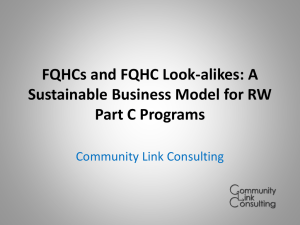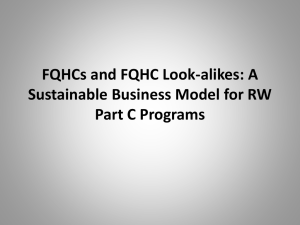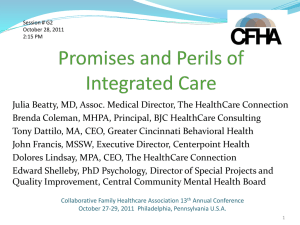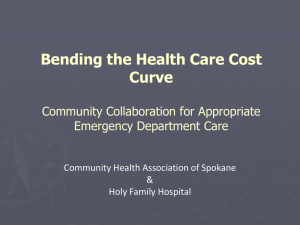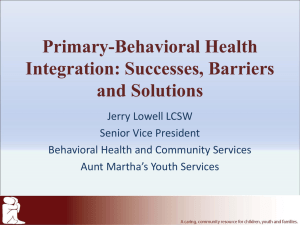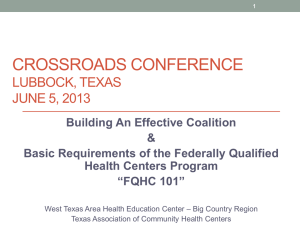Reynolds 2015 Part 3 – Financing
advertisement
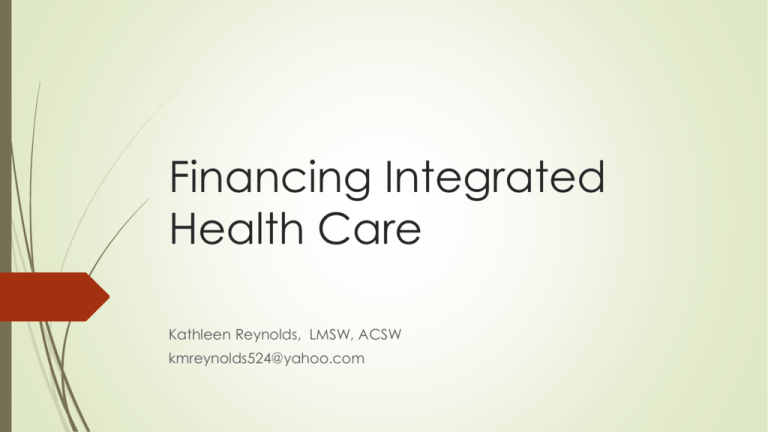
Financing Integrated Health Care Kathleen Reynolds, LMSW, ACSW kmreynolds524@yahoo.com Future Billing Needs Transitioning to Supporting Financial Risk, Accountability, & Utilization Management Practices Provider Compensation Continuum (Level of Financial Risk) Small % of financial risk Fee-forservice No Accountability/empowerment a. 100% case by case UM Performance - based Contracting Begin empowerment b. External facilitated monitoring using data Moderate % of financial risk Bundled and Episodic Payments Shared Savings Empowerment/mod Accountability Large % of financial risk Shared Risk Full empowerment/high accountability Full Accountability c. Internal engagement in monitoring of performance using data Capitation Capitation + Performancebased Contracting d. Internal ownership of performance using data management Source: Rhonda J Robinson Beale, M.D. Optum Chief Medical Officer, External Affairs New Business Model for Integration Must Include Answers to: 1. The Value Proposition: What will your agency provide to Consumers, Families, Community Members, Health Network Partners, & Payers? 2. What are the Start-up Costs? How will it be funded? 3. What is the Model for Linking Outcome Data to Cost (i.e., episode of care logic)? 4. How are Operating Costs (i.e., fix & variable costs) met by a sustainable service model constructed from episodes of care that can be collapsed into a case rate? 5. How is the episode of care logic mapped to the service array and embedded in the team work flows? The Five Core Elements of Bundling www.TheNationalCouncil .org (1)Can you agency define episodes of care by diagnosis, services provided to that diagnosis and length of an episode? (2)Using historical data, can you cost out the episodes of care in item 1? (3)In your costing can you add to the direct costs an approvable indirect cost rate and spread the costs across the various costs? (4)Can staff electronically collect data to verify services provided to/for each episode? (5)Can you quality improvement systems monitor bundles services and rates? Building the Episode of Care www.TheNationalCouncil .org 1. Must define an episode of care including dx, services bundle, and episode duration. 2. Using historical data calculate your cost to provide the episode. 3. Determine how a bundled payment would be divided across staff and overhead costs. 4. Design policy, procedures, & training so staff can deliver services efficiently and effectively (i.e., use of EBP and treat to target). 6 Care Coordination Elements Care Coordination Job Duties: Accountable for overall care management and care coordination, and both provide and coordinate all integrated service. Responsible for needs and goals. overall management and coordination of the consumer's integrated care plan, including physical health, behavioral health, and social service Conduct case reviews on a regular basis Uses an electronic registry for population management Life long services available National Best Practice Whole Person Orientation (physical, behavioral, social service needs) Population Management Approach Care Transitions Evidence Based Protocols for diabetes, heart disease, tobacco, depression Data Based Decision Making Improvement in health care utilization and social capital Care Coordination The Care Coordination Standard: When I need to see a specialist or get a test, including help for mental health or substance use problems, help me get what I need at your clinic whenever possible and stay involved when I get care in other places. Services are supported by electronic health records, registries, and access to lab, x-ray, medical/surgical specialties and hospital care. Five Core Elements of Care Coordination (1) The organization provides, population based care coordination (2) The organization has an electronic health registry that allows us to collect and feedback core elements of integrated care to care coordinators. (3) The organization’s care coordination allows for life-span services. (4) The organization provides assistance with care transitions from physical and psychiatric hospitalizations. (5) The organization has implemented at least two evidence based, primary care interventions such as diabetes management, high blood pressure management, etc. Current Billing Options The Concept of “Community Health Money” Organizations are stewards of public funding –the money is not owned by any particular organization – it is the community’s money. When money is “pooled” for services return on investment is to the community services. Program from what is best for the consumer & the community, then figure out who finances it. Begin with the Consumer In Mind… Reduce turf wars over money by focusing on the consumer. What is possible in the community &/or what would you like to be available? Do not think about “what is paid for”. Once you’ve determined what you want, convene finance folks (conservative & creative) to determine how to pay for it. Basic Principles of Billing and Reimbursement CPT Codes (Current Procedural Terminology) Behavioral Health Codes 908xx series (MH & SU) Traditional behavioral codes by an acceptable licensed and credentialed practitioner for that state and setting (Physician, Nurse Practitioner, Masters Social Worker, PhD Psychologist) Telemedicine (usually the same code as face to face service with a modifier) Typically these services are billable by an acceptable licensed and credentialed practitioner for that state and setting Case Management Can only be billed by an acceptable licensed and credentialed practitioner for that state and setting Generally a CMHC service Interim Financing & Billing Worksheets - CIHS Designed to help agencies understand billing for integrated health services using the public safety net system. • Type of Agency (FQHC, CMHC) • Funding Source (Medicare, Medicaid) • CPT Code • Diagnosis • Practitioner Discipline & Credential The worksheets are posted on the CIHS website: www.integration.samhsa.gov Tips/Opportunities for Billing 1. Interim Financing Solutions for Integrated Healthcare Worksheet 2. Two Services in One Day 3. 96000 Series of Codes 4. Case Management 5. Screening Brief Intervention & Referral to Tx (SBIRT) 6. Dear Medicaid Director State Option 7. Health Home State Plan Amendment Option Two Services in One Day Myth: The federal government prohibits this or Medicaid won’t pay for this! Reality: This is a state by state Medicaid issue, not a federal rule or regulation – Texas does allow this. Federal Citations: ◦ Medicare will cover a physical health and mental health visit same day/same provider – CFR Title 42 Volume 2, Part 405. Section 405.2463 Case Management Billable for Special Populations. If CMHC staff are leased & co-located in an FQHC clinic they can bill. Peers? The 96000 Series Codes Approved CPT Codes for use with Medicare right now Some states are using them now for Medicaid State Medicaid programs need to “turn on the codes” for use Behavioral Health Services “Ancillary to” a physical health diagnosis (e.g., diabetes) The 96000 Series Codes Health and Behavior Assessment/Intervention (96150-96155) Health and Behavior Assessment procedures are used to identify the psychological, behavioral, emotional, cognitive and social factors important to the prevention, treatment or management of physical health problems. 96150 – Initial Health and Behavior Assessment – each 15 minutes faceto- face with patient 96151 – Re-assessment – 15 minutes 96152 – Health and Behavior Intervention – each 15 minutes face-to-face with patient 96153 – Group (2 or more patients) 96154 – Family (with patient present) 96155 – Family (without patient present) Screening, Brief Intervention, Referral for Treatment (SBIRT) Approach to the delivery of early intervention and treatment services for persons with SA disorders or those at risk of developing these disorders. Primary care centers, hospital emergency rooms, trauma centers, and other community settings provide opportunities for early intervention with at-risk substance users before more severe consequences occur. Screening quickly assesses the severity of substance use and identifies the appropriate level of treatment. Brief intervention focuses on increasing insight and awareness regarding substance use and motivation toward behavioral change. Referral to treatment provides those identified as needing more extensive treatment with access to specialty care. Disease Management Payments for Primary Care of Seriously Mentally Ill 2005 “Dear Medicaid Director Letter” (precursor to ACA 2703 Health Home Option). Currently available to states. Allows CMHC’s to draw down disease management funding for SMI and Developmentally Disabled population Michigan Project • Tailored to persons with SMI, Developmental Disabilities and Substance Abuse Disorders • Disease Management for SMI - dollars to CMH; CMH pays primary care FQHCs are a critical component of the 2010 ACA Grant Funding will nearly triple over five years Proposed FQHC Grant Funding $9,000,000,000 $8,000,000,000 $7,000,000,000 $6,000,000,000 $5,000,000,000 $4,000,000,000 $3,000,000,000 $2,000,000,000 $1,000,000,000 $0 $8.33B $6.45B $7.33B $4.99B $2.98B $3.86B FY2010 FY2011 FY2012 FY2013 FY2014 FY2015 FQHC Standalone Approach Behavioral Health Expansion Grant Funding available, often each year, to expand BH services in FQHC settings Most recent application January 2011 All New Starts must have behavioral health services • Direct Hires • Contract with local CMH CMHC Standalone Models In many states CMHC must apply for a new Medicaid # to bill for Primary Care Services • Must apply first for Medicare # to get the Medicaid # • Exception: In Ohio, CMHC’s with Risperdal license can bill for primary care Accreditation Considerations • Depending on accrediting body (Joint Commission, CARF, NCQA) your organization may need to become accredited as an ambulatory care facility to provide physical health services. This whole process can take 2-3 years FQHC/CMHC Partner Models FQHC bill by encounter rates-Perspective Payment Model. Receive the same amount of funding for a 10 minute visit as they do for a 1 hour visit. Contracting with FQHC • Leasing Options for staff • Psychiatrists • Consulting Psychiatrist Model (Regional MHC Indiana) • LICSW/LMSW Cost offset approach for Indigent population • FQHC receive federal funds to cover the cost of indigent CMHC can provide Case Management FQHC/CMHC Partner Models You may be surprised for example: In one Fee for Service state, for psychiatric medication service 90862 • A university medical center clinic is reimbursed $12.50 • The same visit at a CMHC is reimbursed $39.92 • At an FQHC, the visit would be reimbursed at $80-88 In a nearby Fee for Service and managed care state, for 90862: • A university medical center is reimbursed $19.53 • The same visit at a CMHC is reimbursed $210.87 • At an FQHC, the visit would be reimbursed $66.82-155.64 FQHC/CMHC Partner Model 340B Pharmacy benefits • Individual receiving services enrolled in FQHC/CHC • Broader formulary • Significantly reduced rate FQHC apply for change of scope • Mirror scope of primary location to the new CMHC location • Original scope has to include Behavioral Health or apply to have it included • Allows for FQHC to bill for primary care services not able to be billed by CMHC Consumer needs to be enrolled with the FQHC Tips/Opportunities From the Field 1. Process Mapping Billing Work Flow 2. Leadership/Advocacy 3. “Community Health Money Concept” Process Mapping Billing Work Flow Great Team Building Exercise Allows Roles and Procedures to be Defined Identifies inefficiencies (e.g., work-arounds, money left on the table, etc.) Helps establish Standard Operating Procedures Gains commitment from staff

